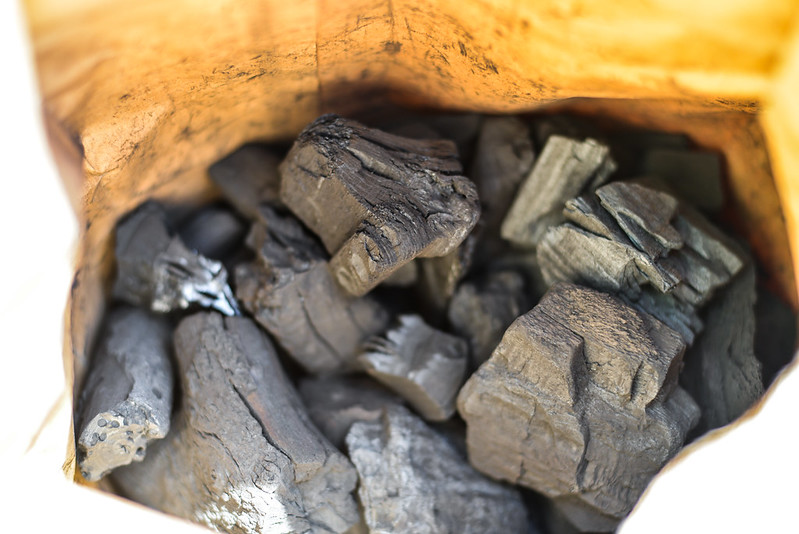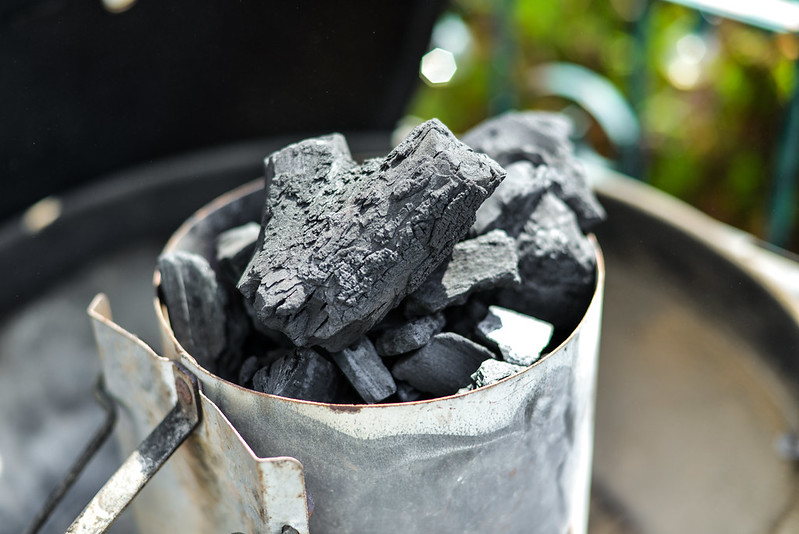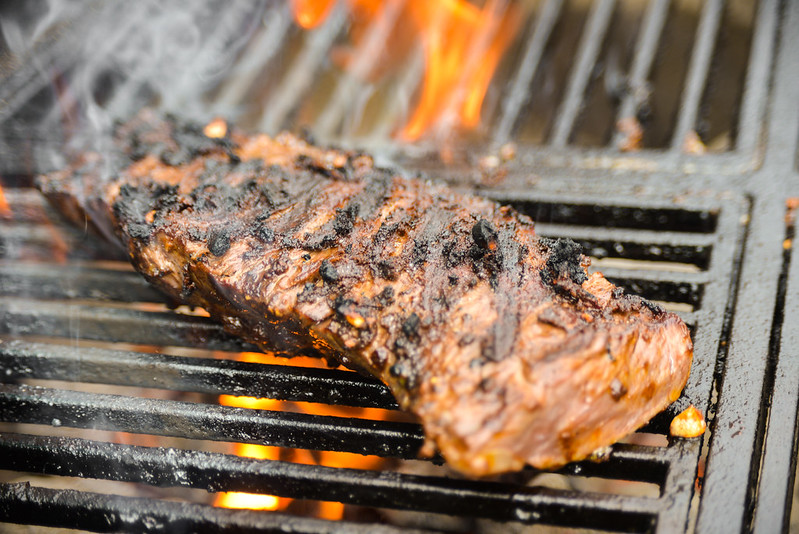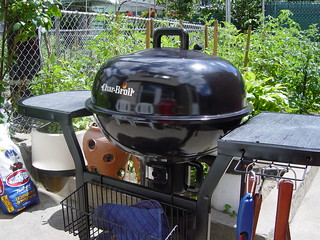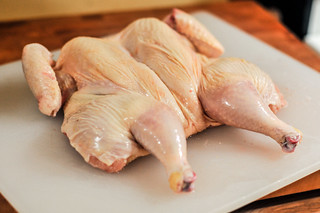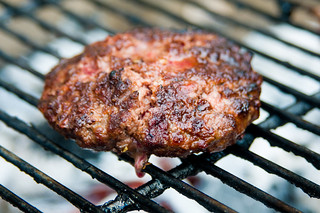Meat Tips: Lump vs. Briquette Charcoal

It's a common occurrence that I'm poised with the question of which form of charcoal—briquette or lump—do I use an why. It's a fiercely debated topic in the grilling world with die-hard loyalists who will go to all lengths to defend their fire source. It's much more of a gray area for me, as I see the ups and downs of both and have reasons to pick one or the other based on the application. After receiving a bag of lump charcoal from Cowboy Brand, I decided to take this edition of Meat Tips to go through the different qualities of charcoal and pit briquette against lump and see how each fair within each category.
What is Charcoal
Before we can get into specifics of how each charcoal preforms, it's good to have a little knowledge of what this stuff is in the first place. Charcoal is made by burning wood in the absence of oxygen. Lump charcoal is the product of the process in its purest form—pieces of wood burned down to be chunks of charcoal.
Briquettes, on the other hand, are kind of like the fast food of charcoal; they're cheap, reliable, can be found on almost every corner, but you really don't want to know what's in them. Unlike the pure lump charcoal, briquettes are manufactured wood by-products compressed with additives that help them light and burn consistently.
Cost
The first question you'll be presented with in your charcoal choice is cost. At the store you'll likely see that briquettes will come in much less expensive, pound-for-pound, compared to lump. In Queens, NY (where I live), I can pick up two twenty-pound bags of Kingsford briquettes for around $17 at Home Depot. Constrast that to the one twenty-pound bag of lump charcoal (Royal Oak is the common in my neighborhood) that sells for $20 and you'll quickly get an idea of the comparative price difference.
Winner: Briquettes
Value
Cost is just one factor though, there's also the measure of value. This is somewhat subjective as the value of using natural wood over a processed product is a personal choice that skews perceived value. So instead I'm talking simply about the fire power that comes in each bag, and in this regard, briquettes offer more burn for the buck. Since briquettes are manufactured, each one is the same shape and size, making every piece in the bag usable. In bags of lump, the charcoal comes in all different shapes and sizes, some that are so small that they fall through the charcoal grates, creating waste. The amount of these unusable bits of lump charcoal varies from brand to brand, and the bag of Cowboy I tested had very few small pieces, so it's worth trying different brands to find the best value.
Winner: Briquettes
Time to Light
One common qualm with charcoal grills is the time to get them lit. While a gas grill just needs to be turned on and preheated for a five to ten minutes, getting a charcoal fire going takes time and energy. So the time from initial lighting until the charcoal is ready to cook—that's when it's covered in gray ash—can be important. My full chimney of lump took only 19 minutes until it was blazing hot and ready to go, while a chimney of Kingsford required 29 minutes to reach that same state.
It's also worth noting that Kingsford briquettes produce a fair amount of off-smelling smoke during this process—a by-product of the additives that help it light better—while the lump charcoal lights up nice and clean with little smoke.
Winner: Lump
Cooking Hot and Fast
When I first poured the lump out onto the charcoal grate and covered the grill, the hood thermometer quickly shot up to 575 degrees. When doing the same with the briquettes, the highest point the thermometer got to was 500. So this means you can cook hot and fast with less charcoal using lump. This is great for anything you want to get a nice sear on like steaks and pork chops. You can reach these higher temps with briquettes, but it will require more fuel.
Winner: Lump
Cooking Low and Slow
I'll preface this section with the fact that I have not done a recent proper test cooking low and slow with lump. Still, the reason I switched to using mainly Kingsford was that briquettes gave me a longer burn time at more consistent temperatures when I was first starting out with smoking years ago. These are two characteristics you want when slow cooking meat, and while you can cook low and slow with lump just fine, it'll likely take more refuels and a little more watchful eye on the temperature.
Winner: Briquettes
Burn Time
That super hot fire comes at a cost with lump charcoal. While you'll get cooking faster and with more heat, the fire will also not sustain itself as long as with briquettes. On an uncovered grill, I get a solid 15 minutes or so of high heat performance with lump charcoal, which then starts to quickly drop, going from medium-high to low temperature in about 30 minutes. Compare that to briquettes which only sustain a really high heat for about 10 minutes, but then burns down at a nice medium-high to medium for around 45 minutes before dropping to a temperature where you'll need to refuel.
Winner: Briquettes
Temperature Control
You can extend those burn times by restricting the airflow to the charcoal—the less air, the lower the temperature and the longer the burn time. This is done through the dampers on your grill or smoker and hitting that right temperature quickly can save you time and let you get more out of your fire. Briquettes take a while to respond to airflow changes—dropping a fresh fire down to the medium 350 degree range can take around 20 minutes. Lump, on the other hand, responds quickly to changes in the airflow. In my experience, lump charcoal requires about half the time as briquettes to increase or decrease temperature based on the amount of oxygen reaching the fire.
Winner: Lump
Ash Production
So all that is good stuff for getting up and running and cooking effectively, but there's always the crap part of working with charcoal—cleaning up in the end. If you're using lump, this won't be much of an issue as it produces very little ash. I often don't have much of anything to clean up after a day of grilling with lump charcoal.
Briquettes are a whole other story—they produce an amount of ash that's maybe just under half their original volume. This can require frequent dumping of the ash catcher and a more lengthy cleanup at the end to rid the grill of all its ash before putting it away.
Winner: Lump
Parting Words
As you can see, each charcoal has its own winning and losing characteristics. I still use both from time to time, but just for convenience and cost value, I'm mainly a Kingsford man. The bag of Cowboy charcoal that I used for this post has me questioning that stance though. I've been so loyal to briquettes for so long that I forgot the ease of lighting the fire with lump and the great heat it outputs, not to mention not having the deal with the chemical smell and heavy smoke that causes a couple of of my neighbors to complain when I have a fire lighting. In the end the choice between lump and briquettes going to be personal based on use, availability, and cost, but I'm betting a lot of you have your own two cents to throw into the ring on this debate, so by all means, go at it!
You Might Also Like
Comments
-
David I stopped using lump because I got tired of having to sweep up the ash that would pop and blow all over my patio during the lighting process. Briquettes may smoke and have an off smell, but dealing with all that ash everywhere was a killer for me.
-
Steve Well-done comparison! I have a BGE and must use lump. I use mostly Royal Oak. The comments point regarding popping is huge. I use a weed burner to get mine going, but the popping makes for a mess and hurts if it gets on the skin.
-
Phil in France The lump/briquette thing also depends on which sort of device you'll be doing your cooking.
For example, I have used argentinian hardwood oak lump - similar to royal oak but from a different producer. It's expensive - 35 euros for a 15 kg bag (http://www.barbecue-co.com/charbon-de-bois-argentin/271-charbon-de-bois-argentin-15-kg-2020000007951.html) - but it beats anything else available here. 'natural' briquettes such as they are don't really exist here yet.
Back to what I was saying - I have a BGE and use that exclusively. As far as ash goes, when I do a 24 hour burn at 225 I get about a dinner plate's worth of ash at bout half an inch in depth. For 24 hours. Same, in fact, as when I do a t-rex style burn at around 600-700 degrees. Perhaps this has something to do with using the egg?
There's also the question of refueling. I use a BBQ Guru (best purchase ever - Josh, curious, what do the competition types think of gurus?) and use the minion method to charge the egg with lump. I have had the egg guru go with a full load of charcoal for -36- hours before. That was at 200 instead of 225, but still.
All of my friends with 'real' bbqs here have webers and use briquettes, and I'm always surprised by the amount of ash generated. -
Vaya Con Carne The Happy Medium: All-Natural Hardwood Briquettes. B&B makes a nice Oak briq that 95% hardwood, 5% vegetable binding and no chemical crap. I'm also told Stubb's all-natural briqs are solid.
Especially for the WSM, the B&B are perfect. 8 hour steady 225-250 burn out of one chimney. Conversely, I can roll 400-450 in the Kettle for 2 hours on one chimney. -
Jason Sometimes, depending on what's on the menu I'll use both lump and briquettes at the same time. Bottom half of the chimney with the briquettes as they take longer to light and the top half with lump. This will give me the high heat to do some steaks right and a longer med/high heat after the steaks come off to do any side dishes such as vegetables, etc.
I tried the new Kingsford Competition all natural briquettes recently and I like that they're more natural but they're still no substitution for lump for high heat searing power but a nice compromise if you can only choose one. -
Larry Nice job on the comparison. I use Stumps briquettes in my smoker (the lump bridges over) and a mix of lump and briquettes in the grill.
-
coma I have been using Fogo lump charcoal with great results this summer in my 250 gallon reverse flow. Whole hog to brisket is has been great.
-
Roy In California, we get Lazzarri hardwood charcoal in both lump and briquet form. Their hardwood briquets are uniform, great and have the same benefits as lump. I don't need kingsford anymore
-
Roy One more thing. If you live in SF Bay Area, Lazzari is a prime charcoal supplier to restaurants. You can buy their stuff at their warehouse in Brisbane(SSF) for way cheaper than the upscale grocery store.
-
Chris I use lump in my two Big Green Eggs and Kingsford blue in my drum and offset smoker.
The one thing I always hear about briquettes is "all the chemicals in them" and that lump is "pure". I have a collection of impurities from lump I use including things such as; melted green glass like objects, unidentified insulation, random pieces of metal, rocks, concrete, wire, and more. Sometimes I catch it before it cooks in the Egg, other times it slips by and I find it in the ash. I use a variety of quality lump including buying pallets of it to get stuff we can't get locally. The two that bother me most are the melted glass like objects and insulation. Who knows what the "glass" really is and what it gassed off into my cooker. -
Mike Does anyone have feedback on taste? Trying to find a charcoal for my green egg that doesn't add such a smokey flavor to the food. It's good for some foods, but not for all.
-
Yuly Springer Id like to invite everyone to check out our website. www.aycarbon.com
Currently our mesquite hardwood lump charcoal is being sold in all of the California Walmarts. We are located distribution in Los Angeles and in N. Cal, Los Banos. -
Guy Jones I have used Trader Joe's hardwood briquettes (re-branded Rancher charcoal) with great results. It it priced at $7.99 for an 18-pound bag. A good deal, in my book. It burns clean and long, and only contains two ingredients: hardwood and cornstarch, the latter used as a binder. I'm also eager to try Coshell briquettes, made from coconut shells. This product receives great reviews and is available at Lowes for $7.99 for an 18-pound bag. Royal Oak also makes hardwood briquettes. I use Royal Oak lump charcoal as well, and I think it's a quality product. I will sometimes mix lump hardwood with briquettes.
In my estimation, the manufacturer, cost or model of one's grill matters less than the fuel one uses. I think that successfull grilling/smoking requires four things -- 1) great ingredients and preparation; 2) solid technique (e.g., temperature control, smoke control, moisture control); 3) effective mods to one's smoker or grill, if necessary (such as replacing thin chrome-barred cooking grates with one made from well-seasoned cast iron), and, elevating the cooking grate if needed, to prevent burning; and, 4) using quality charcoal and smoke woods. Kingsford blue bag simply does not make the grade as a "quality" product in my book. It may burn effectively and predictably, but, where it fails utterly is in its composition -- I prefer not to cook food over charcoal that is made up of 78% coal dust (this according to Kingsford's Material Safety Data Sheet). It seems axiomatic that burning coal dust underneath one's food results in the food absorbing unpleasant aromas and flavors, not to mention, carcinogenic compounds. I don't think it's asking too much to grill/smoke with charcoal made from hardwood, be it in lump or briquette form. I think that anyone who cares in the slightest about their family and friends' health, not to mention, putting forward a tasty and wholesome product, should be grilling with hardwood charcoal, even it it costs slightly more. If you're going to do something, do it right. Saving a buck on a bag of charcoal is less important to me than serving the best grilled or smoked food that I can produce. -
shreyavaidya These coal briquettes are used in place of the traditional and expensive fuels. From the above given details, we can say that the biomass briquetting machine contributes in nation's global energy supply.
-
Martina Edwards Do you supply your own charcoal?
-
Kevin Wiz First thing you need to do is tell your neighbor to mind their own business and also if they don't like the smell, go inside!!!
-
bazol Hi,thanks for the quick reply!
We need for beginning about 25 tones-delivery port Pyrgos,Greece (Peloponnese).Could you give me price for bamboo charcoal also and sandwich briquettes charcoal (about 10 tons of each category)?
Best regards! -
Pine Creek Pit I guess there is an argument for either product. However, what helps me decide what type of product to use is based solely by the feedback and satisfaction of customers I cook for. I have always been one that desired to do the best job I could do, with the best products. I find it a bit unnerving to think that some folks decisions are based mainly on cost. Well, here's something to think about; satisfying the customer with a great product and their yearning to have more of the same is things that make my decision a no brainer. High quality Lump charcoal - Parker's Premium Lump Charcoal is all I strike a match to.
-
Paps Bratton Good article and good comparison. For me I use both. When I'm brazier cooking like steak and burgers I use a 2 zone method and reverse sear. A low to medium- low heat, turning often and when close to temp I put them on a high heat to get the sear I want.
I'm with you on Cowboy brand. Great product. Their briquettes are outstanding as well. No weird chemicals for binding but vegetable based binders. No off odors and great wood smoke flavor.
